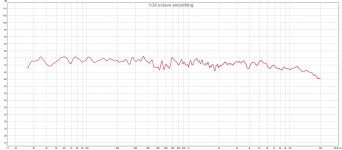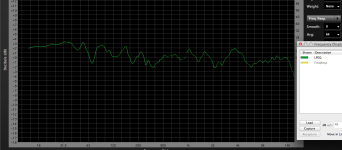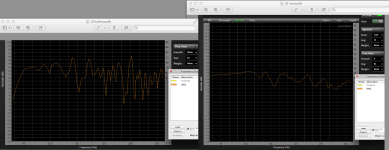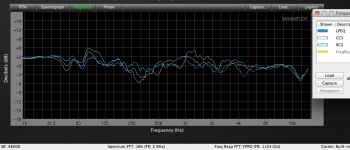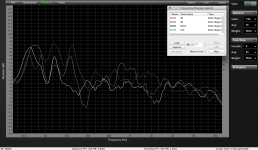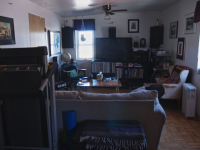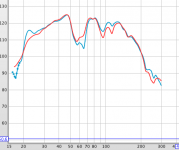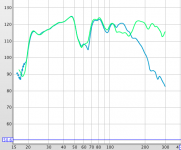Do you have the means of varying the alignment of your bass or mid drivers to illuminate the thread?
The receiver I'm using to drive them offers time alignment on all channels. And of course the possibility of moving the subwoofer around is always open 🙂.
I adjusted its phase a bit and repositioned it a bit along the wall. The response is now a lot flatter through the crossover region.
I'm with you that the room can have a greater impact. The response in my living room cleared up considerably after I effectively removed one wall 🙂.
Member
Joined 2003
Ben,
This isn't my current top-end, but the subs haven't changed.
Why not try alignment...what have you got to lose?

This isn't my current top-end, but the subs haven't changed.
Why not try alignment...what have you got to lose?

Open Baffle system
Here's a set of curves from a (now disassembled) dipole planar setup with BG RD-75's @ 15 feet, 0, 15, 30, 45, and 60 degrees off axis: (not much smoothing) crossover @600hz, 2nd order electrical
rather uniform across a broad swath, the 15 degree off axis(red) is actually smoother than the on-axis (green) response from maybe 1K on up:
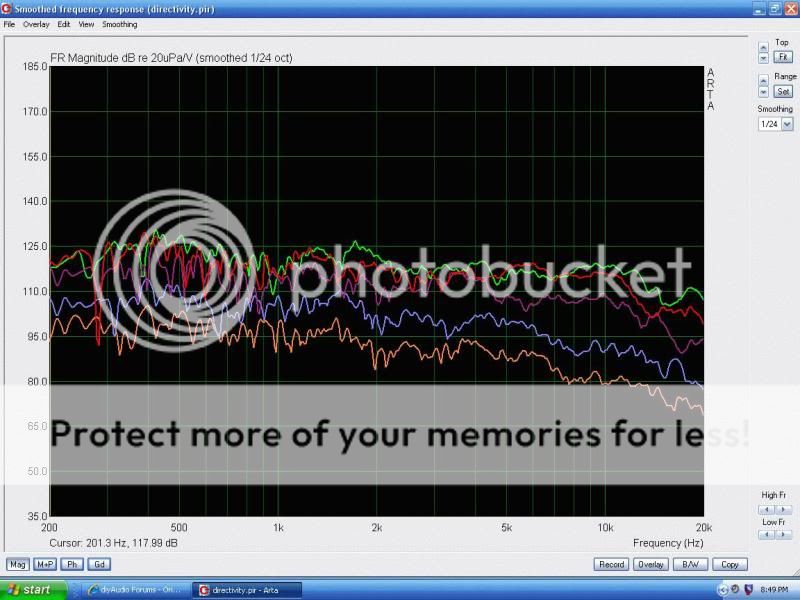
Did not run below 200 hz... as I have 4 12" subs arrayed around the largish room (25' x 20' x 2 story) positioned empirically for smoothest bass in the listening area. I have awesome smooth, clean, punchy, and not overpowering bass, but I may try some measurements to validate what I hear (or not)!!
Here's a set of curves from a (now disassembled) dipole planar setup with BG RD-75's @ 15 feet, 0, 15, 30, 45, and 60 degrees off axis: (not much smoothing) crossover @600hz, 2nd order electrical
rather uniform across a broad swath, the 15 degree off axis(red) is actually smoother than the on-axis (green) response from maybe 1K on up:

Did not run below 200 hz... as I have 4 12" subs arrayed around the largish room (25' x 20' x 2 story) positioned empirically for smoothest bass in the listening area. I have awesome smooth, clean, punchy, and not overpowering bass, but I may try some measurements to validate what I hear (or not)!!
Last edited:
resolution
auplater:
A resolution of 15 dB is very high. Use 5 dB increments like the one below instead.
Hi
Yeah, whatever... curves are curves in engineering you know?? It's what you DO with them that matters
... it was 8 years ago, during setup and I lost many of the higher rez scans...
Plus, I was in the middle of setup and looking mostly at dispersion, not flat response.
I actually achieved very flat response (maybe +/- 4db 400 hz - 12 khz) with room correction, but disliked the sound
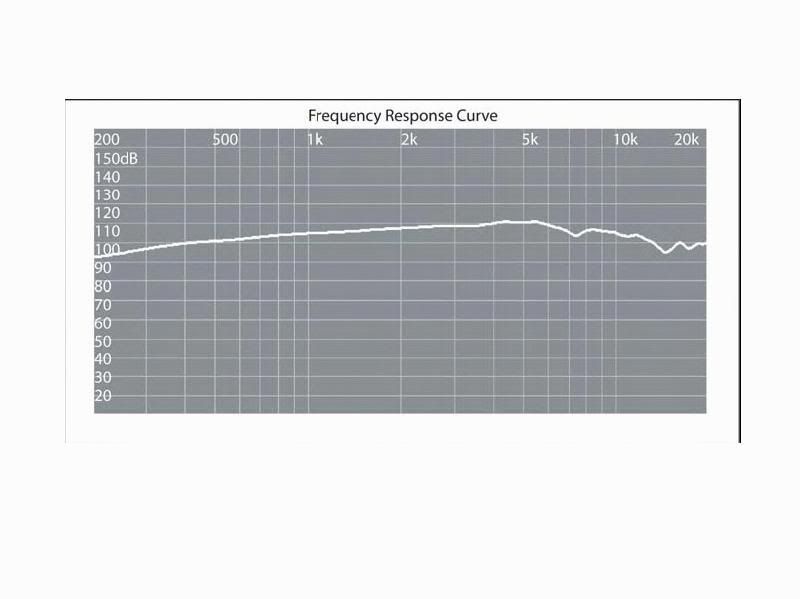
Last edited:
At the risk of being patronized once again about being the last guy on the forum to try DSP (after trying for years to get a straight answer on distortion specs....that I still don't have), I do plan on trying it - after the motorcycle season ends for me.Why not try alignment...what have you got to lose?
I'm sure everybody knows the famous joke Mark Twain made about baptism. That's how I feel about "alignment." You can ALWAYS try it by twiddling the knobs or software and always get some result. I'll give it a try soon enough.
In post #1715 I describe a bit about my system and other facts are self-evident from my signature and here and there. Mark Twain aside, are you sure you have a good grasp of the issues joining two large mid-room ESLs to a Klipschorn and a mid-wall OB or are you just offering me friendly but theory-bereft encouragement to do the Nike thing*?
Ben
*Just Do It
Member
Joined 2003
Just friendly advice...I've never seen your room.
Right.
Now the Klipsch bass folded corner horn has an internal path somewhere around 10 feet, let's say. (Some Klipschorn owners have experimented with alignment for those 10 feet. But at least the full Klipschorn unit has the two upper horns on axis.)
It has its two mouths along each of the adjoining walls.
Unless you are sitting on a line 45-degrees to the corner, these will be a different distances/alignments to you. And to any mid-range. And really fouled-up, alignment speaking, to the other mid. And to any other sub like my giant mid-wall OB.
Where should we begin, dimensionally speaking?
I hope advocates of alignment are just itching to solve my puzzle with a few theory-based hints. I also suspect certain others are giggling as I post this.
Ben
Member
Joined 2003
Ben,...the Klipsch bass folded corner horn has an internal path somewhere around 10 feet, let's say.
It has its two mouths along each of the adjoining walls.
Unless you are sitting on a line 45-degrees to the corner, these will be a different distances/alignments to you. And to any mid-range. And really fouled-up, alignment speaking, to the other mid. And to any other sub like my giant mid-wall OB.
Where should we begin, dimensionally speaking?
You describe a system and placement prone to large deviations in room frequency response, with measurements to back up said description.
If you were to draw out your room with speaker and listening positions and dimensions the reason (if not caused by the speaker's response) for the nulls would be possible to solve.
With either L or R mains with the corner horn there is a 16-20 dB dip at 65 Hz.
1130 FPS/65 =17.38 feet, from your room descriptions sounds like the horn path length + the extra distance from the mains could be causing the null, the orange trace in # 1715 has 5 dB less null at 60 Hz.
If the corner horn or either L/R speaker don't show the deep null from 55-80 Hz when played individually, the problem is time alignment, if they still show the null individually, it is a combination of the room and LP (measurement Listening Position).
If the ESLs radiate from the back as well as the front, the distance from the rear wall will of course be a "choose your poison" decision regarding the frequencies that will null at any given LP.
Today I did some testing at a variety of positions in my room.
With the exception of the long dimension of our rooms, our rooms are not much different in size, mine is 10' 9" wide x 7'7" on the low side x 8' on the high side x 19'11" long (3.3m x 2.3 m x 2.46m x 6.13m).
However, my subs and mains are within 2-4 ms arrival time at the LP, within 1/4 wavelength through (most of) the acoustical crossover.
With EQ (and smoothing) the response at the "prime" couch seats are +/-3 dB to +/-6 dB from 16 Hz to 16K, the "cheap seats" off axis along the wall are +/- 9 dB with more LF and reduced and rougher HF.
No smoothing, +/- 6 dB.
With more data points in, we have Markus' system showing a starting deviation similar to the 16-25 dB deviations in your posts 1397 and 1713, his post #1625 shows a reduction in frequency response deviation in the crossover transition region from around 17 dB to only 8 dB using delay on (some of) his subs.
Brian 's post in #1718 shows a wider deviation of 27 dB, in 1721 he says it was "a bit better" after adjusting phase and positioning.
Paul posts in 1722 around +/- 5 dB deviation.
Omholt in 1724 has a similar deviation to mine, +/-3 dB.
Auplater's curve in 1725 shows around 18 dB variation between 200 Hz and 5 Khz, the widest deviation posted, it would be interesting to see if the addition of his four 12" subs around the room result in a measurable improvement.
So far those posting charts with time alignment capability have shown improvement, while Earl found in his system it made things worse in some positions while improving others, as one would expect.
We can't all sit in the best seat 😉.
Art
Attachments
OK, good stuff to think about. Many thanks. Glad to learn that none of us has any handle on aligning the kind of diverse speakers found in many systems such as mine, or they intend to keep it a secret if they do.
Good to see that other systems got better mic curves through alignment and other activities. I'd have to go back to check which posts had curves showing nothing but "with" and "without" curves done in immediate succession, because that's the only pairing that provides unassailable evidence as far as alignment benefits per se. Should be a simple matter for somebody to do it, if it hasn't already been posted.
But for me (and none of us can speak for Earl), since my L+horn and R+horn traces look about the same, alignment likely has little to do with my sound, as you propose. Unless that happened by lucky coincidence.
As far as room/dimension/location issues, I think it is fair to say my corner horn will have to forever stay in its corner, large ESL panels where they are, and my chair, well, where it is. And my giant mid-wall OB sub is screwed to the wall studs... but can be moved.
Back to the thread, a person setting up a system may have to choose between locations for the elements which make the speakers, chair, and room work well OR compromise those choices by also considering whether or not that system will ever be alignable.
In a way, life is easier for me since I have little wiggle room about where to put a corner horn!
Ben
Good to see that other systems got better mic curves through alignment and other activities. I'd have to go back to check which posts had curves showing nothing but "with" and "without" curves done in immediate succession, because that's the only pairing that provides unassailable evidence as far as alignment benefits per se. Should be a simple matter for somebody to do it, if it hasn't already been posted.
But for me (and none of us can speak for Earl), since my L+horn and R+horn traces look about the same, alignment likely has little to do with my sound, as you propose. Unless that happened by lucky coincidence.
As far as room/dimension/location issues, I think it is fair to say my corner horn will have to forever stay in its corner, large ESL panels where they are, and my chair, well, where it is. And my giant mid-wall OB sub is screwed to the wall studs... but can be moved.
Back to the thread, a person setting up a system may have to choose between locations for the elements which make the speakers, chair, and room work well OR compromise those choices by also considering whether or not that system will ever be alignable.
In a way, life is easier for me since I have little wiggle room about where to put a corner horn!
Ben
I'd have to go back to check which posts had curves showing nothing but "with" and "without" curves done in immediate succession, because that's the only pairing that provides unassailable evidence as far as alignment benefits per se. Should be a simple matter for somebody to do it, if it hasn't already been posted.
Not that simple here. My receiver does both TA and EQ via an automated process. While it is easy to switch off the TA/EQ to do before/after measurements, but it may not be easy to determine which are due to TA adjustment and which are due to EQ adjustment.
SWMBO's occupying the living room again, so I won't be able to do those measurements in a hurry anyway.
To paraphrase what I see here:
> What we all want is smooth SPL in frequency and spatially - this has to be the primary goal of sub design and layout.
> There are many ways that one can achieve this with the available parameters which include equalization, delay, sub placement, etc.
> Some find good results with "time alignment" others have not found this necessary, but no one has any more data than "it sounds good to me" to suggest that time alignment works any better than any other approach. I don't see it as bad, but I also don't see it as necessary (except as below).
> " time alignment" is essential if the sub to mains overlap occurs in the non-modal region of a room, such as would be the case in a large venue. In a small room where the subs and mains interact through discrete modes in the room it is not at all clear what "time alignment" even means let alone that it is necessary.
This is how I see the situation based on my decades of research into this problem.
> What we all want is smooth SPL in frequency and spatially - this has to be the primary goal of sub design and layout.
> There are many ways that one can achieve this with the available parameters which include equalization, delay, sub placement, etc.
> Some find good results with "time alignment" others have not found this necessary, but no one has any more data than "it sounds good to me" to suggest that time alignment works any better than any other approach. I don't see it as bad, but I also don't see it as necessary (except as below).
> " time alignment" is essential if the sub to mains overlap occurs in the non-modal region of a room, such as would be the case in a large venue. In a small room where the subs and mains interact through discrete modes in the room it is not at all clear what "time alignment" even means let alone that it is necessary.
This is how I see the situation based on my decades of research into this problem.
Ben,... since my L+horn and R+horn traces look about the same, alignment likely has little to do with my sound, as you propose. Unless that happened by lucky coincidence.
Yesterday's more extensive system testing gave me a more clear understanding of what were room problems, and what were speaker problems, and what were speaker interaction problems, and led to a different and smoother EQ solution.
Your L/R plus subs share the major dip, but have a 5 dB difference at the lower part of the dip.
If you think a 5 dB difference in a 20 dB response dip is "about the same", then all the discussion is academic 🙂.
However, if you do desire a smoother response, I'll repeat:
If the corner horn, IB, or either L/R speaker don't show the deep null from 55-80 Hz when played individually, the problem is time alignment, if they still show the null individually, it is a combination of the room and LP (measurement Listening Position).
If the ESLs radiate from the back as well as the front, the distance (and angle to) the rear wall will determine which frequencies will have the most severe nulls at any given LP.
Changing the ESL distance from the wall may be at least a partial solution to the large frequency deviations you see/hear, a simple test of each speaker by itself (try with and without the filters you normally use) would help determine what choices (if any) could be made to smooth the system response.
Converting the OB to an IB may also be a consideration, depending on the
baffle size, it may be causing the 50-70 Hz "suckout"- individual testing of the components will give you an idea of how you might "divide and conquer".
Art
Granted, eyeballs differ but in my room (and many rooms) all the pairings are a bit wonkee here and there, I think most people looking at post 1713 would deny your smiley innuendo that the differences are (a) audibly material and/or (b) worth tossing one more very complex piece of machinery into the chain on a whim.Ben, your L/R plus subs share the major dip, but have a 5 dB difference at the lower part of the dip.
If you think a 5 dB difference in a 20 dB response dip is "about the same", then all the discussion is academic 🙂.
However, if you do desire a smoother response, I'll repeat:
If the corner horn, IB, or either L/R speaker don't show the deep null from 55-80 Hz when played individually, the problem is time alignment, if they still show the null individually, it is a combination of the room and LP (measurement Listening Position).
If the ESLs radiate from the back as well as the front, the distance (and angle to) the rear wall will determine which frequencies will have the most severe nulls at any given LP.
Changing the ESL distance from the wall may be at least a partial solution to the large frequency deviations you see/hear, a simple test of each speaker by itself (try with and without the filters you normally use) would help determine what choices (if any) could be made to smooth the system response.
Converting the OB to an IB may also be a consideration, depending on the
baffle size, it may be causing the 50-70 Hz "suckout"- individual testing of the components will give you an idea of how you might "divide and conquer".
Art
Your (otherwise plausible and kindly provided) suggestion about alignment interaction is not germane because both the giant OB has only slight influence around 65 Hz, and the mid ESLs (ditto).
So.... I'm with Earl (and if you read his last post carefully, he distinguishes bass from treble treatment).
In passing I mentioned something earlier that might justify repeating: sometimes we "adjust" our speakers physically or electronically to improve the freq trace without touching the volume knob. Does your mic ever wonder where the extra oomph went or came from? My point is that the same total speaker power is going into the room. In one case, the mic gets a flatter response. But taking your room as a whole, it may not be better sound.
Don't forget, in doing a lot of these audio tests, we are doing what grade school teachers lambaste as "teaching for the test."
Ben
Ben,Your (otherwise plausible and kindly provided) suggestion about alignment interaction is not germane because both the giant OB has only slight influence around 65 Hz, and the mid ESLs (ditto).
A picture (chart) is worth a thousand words.
I don't know if you mean the OB and ESLs don't have much of any output in the 65 Hz range, or there is some other reason they would have "only slight influence around 65 Hz".
You refer to the ESLs as "mid", what crossovers and frequencies are you using between mid and bass?
Are the OB and corner horn sharing the same crossovers and frequencies?
Art
Cross-over freqs in my signature.Ben,
A picture (chart) is worth a thousand words.
I don't know if you mean the OB and ESLs don't have much of any output in the 65 Hz range, or there is some other reason they would have "only slight influence around 65 Hz".
You refer to the ESLs as "mid", what crossovers and frequencies are you using between mid and bass?
Are the OB and corner horn sharing the same crossovers and frequencies?
Art
Mid ESLs don't have much output around 65 Hz, nor does the giant OB: it's the room, not the interaction. (For sure, charts better than me waving my hands in the air.)
OB and Klipsch running on same amp (don't ask why). OB only contributes much below 45 Hz but pretties up the trace down to below 20 Hz (BTW... the rumble filter is on).
Ben
OK, here're the charts, 16-300 Hz. This afternoon with some traffic outside, there is variability even in successive identical tests.
The first chart shows the horn and then the horn plus the OB. Pretty major room (or room, speaker location, chair location, speakers, etc.) influence, very minor speaker interaction or alignment problems.
The second chart shows the horn and OB (repeated from first chart) and then with the mid added. Again, its the room anywhere south of the cross-over region. And the cross-over region isn't too bad*.
Hope that puts the matter of bass alignment to rest (at least for my room).
Ben
*my 24dB/8ave old electronic crossover made and calibrated courtesy of Bell Labs 45 years ago (still in service in Florida), was a whole lot better than my current Behringer analog device, although lacking any front-panel adjustments. Oh well.
The first chart shows the horn and then the horn plus the OB. Pretty major room (or room, speaker location, chair location, speakers, etc.) influence, very minor speaker interaction or alignment problems.
The second chart shows the horn and OB (repeated from first chart) and then with the mid added. Again, its the room anywhere south of the cross-over region. And the cross-over region isn't too bad*.
Hope that puts the matter of bass alignment to rest (at least for my room).
Ben
*my 24dB/8ave old electronic crossover made and calibrated courtesy of Bell Labs 45 years ago (still in service in Florida), was a whole lot better than my current Behringer analog device, although lacking any front-panel adjustments. Oh well.
Attachments
Last edited:
Ben,The first chart shows the horn and then the horn plus the OB. Pretty major room (or room, speaker location, chair location, speakers, etc.) influence, very minor speaker interaction or alignment problems.
The second chart shows the horn and OB (repeated from first chart) and then with the mid added. Again, its the room anywhere south of the cross-over region. And the cross-over region isn't too bad*.
Hope that puts the matter of bass alignment to rest (at least for my room).
If you used a shallow crossover slope with speakers extending lower the big dip could have been due to alignment, but with a 24 dB per octave crossover at 110 Hz looks like alignment is not the problem there.
The 6 dB drop in the crossover region when the mids are added indicate they are reverse polarity from the lows, if in polarity the 110 region should rise in level when added.
Typically to compensate for too much level at the crossover point one uses an "underlap", say 110 Hz for the lows and 120 Hz for the mids, or just drop the level with EQ at the crossover point.
Still curious what the combination of OB and horn look like when the OB polarity is reversed.
Attachments
Last edited:
Not sure as I appreciate you again offering me patronizing newbie kind of advice as if I haven't explored all that kind of simple stuff for many decades. No doubt your intentions are well-meant, but gimme a break.Ben,
If you used a shallow crossover slope with speakers extending lower the big dip could have been due to alignment, but with a 24 dB per octave crossover at 110 Hz looks like alignment is not the problem there.
The 6 dB drop in the crossover region when the mids are added indicate they are reverse polarity from the lows, if in polarity the 110 region should rise in level when added.
Typically to compensate for too much level at the crossover point one uses an "underlap", say 110 Hz for the lows and 120 Hz for the mids, or just drop the level with EQ at the crossover point.
Still curious what the combination of OB and horn look like when the OB polarity is reversed.
I posted my curves to disprove your point of view (which I think they did successfully a few times over).... not to get your advice on my system, even when well-meant.
Tomorrow should we arm-chair psychoanalyze your bumps and dips?
B.
Last edited:
- Home
- Loudspeakers
- Subwoofers
- Multiple Small Subs - Geddes Approach
